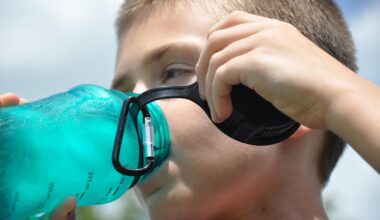Using Compression Gear to Speed Up Trail Running Recovery
Trail running, a sport gaining immense popularity, requires dedication and resilience. After an intense trail run, recovery is crucial for maximum performance and injury prevention. One innovative recovery method that runners have embraced is the use of compression gear. Compression garments, such as sleeves, socks, and tights, are designed to apply gentle pressure to the limbs. This pressure helps improve circulation, which enhances the delivery of oxygen and nutrients to the muscles. Additionally, this process can assist in reducing muscle soreness and fatigue after prolonged physical exertion. The benefits of compression gear extend beyond merely physical comfort. Many runners report feeling more energized and less fatigued, which can lead to better performance in subsequent runs. With so many options available, it is essential to choose high-quality compression products that fit well and offer the right level of compression. Incorporating these garments in your post-run routine can significantly impact how quickly you recover from intense trail running sessions. Remember, effective recovery methods contribute to overall running success and sustainability in the sport.
To better understand the impact of compression gear, it’s helpful to explore the science behind it. Research has indicated that compression garments may enhance venous return, which refers to the blood flow returning to the heart. Improved venous return means that oxygen-rich blood is delivered more efficiently to the muscles that need it most, particularly after strenuous exertion. This translates to faster recovery times and reduced risk of injuries, such as strains and tears. Furthermore, compression gear can lead to reduced lactate accumulation during exercise, which is a key factor associated with muscle fatigue. By minimizing the amount of lactate in the muscles, runners can experience less cramping and prolonged endurance on their trails. It’s also worth noting that compression wear can create a supportive environment for muscles, helping them to stabilize during running. This support can enhance comfort and boost confidence when tackling challenging terrain. As trail runners consider their recovery methods, compression gear represents a significant advancement in ensuring that their bodies are prepared for the next adventure.
Types of Compression Gear
There are various types of compression gear available on the market, each designed to serve a specific purpose in recovery and performance. One of the most common types includes compression socks, ideal for targeting the lower legs, helping to alleviate fatigue and reduce swelling. These socks are particularly beneficial after long runs, as they focus on stabilizing the calves. Next, compression tights offer full-leg coverage and are designed for those who wish to support their entire lower body during recovery. They often provide a comfortable fit that can be worn throughout the day or during light activities. Sleeves, whether for arms or legs, are lightweight options that provide targeted compression without the bulkiness of full garments. Many runners prefer these sleeves for their versatility and ease of use. Additionally, sports bras with compression features offer support to female runners, ensuring comfort during workouts. Choosing the appropriate type of compression gear depends on personal preferences and specific recovery needs, ultimately enhancing the recovery process for trail runners.
When implementing compression gear into your recovery routine, timing is crucial. Ideally, wearing compression garments immediately after a run can maximize their effectiveness. This is when your muscles are in the most need of support, as they begin to repair and replenish. By wearing your compression gear for several hours post-run, you can significantly boost blood flow and facilitate the removal of metabolic waste from your muscles. Some athletes also choose to wear compression gear during their runs, providing support while they tackle challenging trails. This can help reduce muscle oscillation, which often leads to microtears and delayed onset muscle soreness (DOMS). Additionally, pairing compression gear with other recovery methods, such as hydration and nutrition, ensures a comprehensive approach to recovery. Adequate fluid and nutrient intake will complement the benefits of compression gear, promoting optimal recovery during your downtime. By understanding the perfect timing and synergy between these methods, trail runners can enhance their recovery and return to the trails stronger than ever.
Practical Recommendations for Use
When selecting compression gear, comfort, fit, and the level of compression are essential factors to consider. Many brands offer different compression levels, usually ranging from mild to high compression. It’s important to choose a level that aligns with your running intensity and personal comfort. Ideally, compression gear should be snug but never restrictive, allowing for freedom of movement. New users might begin with lighter compression options to allow for adaptation before gradually moving to higher compression levels. Furthermore, the material and design can impact the effectiveness of compression gear. Look for breathable fabrics that wick moisture away, ensuring comfort during wear. Regular washing and care are also important to preserve the compression quality over time. Additionally, consider integrating specific recovery sessions that involve active recovery with the use of compression gear. Activities like light jogging or walking while wearing compression garments can further stimulate blood flow and expedite recovery. Finding what works best for you through trial and error is fundamental, ensuring that your trail running experience remains enjoyable and productive.
In conclusion, recovery is a vital aspect of trail running, and compression gear serves as a valuable ally in this process. By understanding how effectively to incorporate compression garments into your post-run practices, you can optimize your recovery and performance levels. Compression gear applies pressure that improves blood circulation, allowing your muscles to recover more efficiently. With the increased popularity of trail running, runners are increasingly seeking methods to enhance their endurance and recovery strategies. As you explore different gear and techniques, remember that individualized experiences may vary. Not all runners will respond the same way to compression gear, but its potential benefits make it worth trying. Evaluate what types of compression wear suit your preferences best and how your body responds to them. Comprehensive recovery involves a combination of practices, including hydration, nutrition, and rest, along with compression gear. Ultimately, enhancing recovery will lead to improved performance on the trails and a more enjoyable experience in the sport you’re passionate about.
Future Trends in Recovery Technology
Looking ahead, the field of recovery methods in trail running is evolving rapidly. With advancements in technology, we are seeing innovative products designed to enhance recovery even further. Compression gear is likely to become more technologically sophisticated, incorporating features like biofeedback sensors, which can monitor muscle fatigue levels and adjust compression in real-time. Such advancements can provide personalized support based on your unique running patterns and recovery needs. The future may also hold the potential for smart fabrics capable of enhancing circulation through electrical stimulation, complementing the benefits of traditional compression gear. Moreover, researchers are continuously studying the effects of various materials on recovery times, searching for fabrics that can maximize recovery while ensuring comfort. With an increasing focus on recovery methods among athletes, we can expect greater investment in the research and development of advanced recovery technologies. As trail running continues to gain traction, embracing these trends will provide runners with more resources to aid their performance, ensuring they remain competitive and injury-free on their paths ahead.
As you consider the various recovery techniques available, remain open to experimenting with new compression gear options. The world of trail running offers numerous exciting developments designed to support your performance journey. Case studies highlight the effectiveness of compression gear based on feedback from professional runners, suggesting that incorporating this method can significantly improve how you recover after grueling races. Pay attention to your body’s signals as you trial different types of compression garments, adjusting your selections based on comfort and performance. Connect with fellow runners to share insights and recommendations on the best products available in today’s market. Engaging with the running community not only fosters camaraderie but may also lead you to valuable experiences and insights that can elevate your recovery journey. Compression gear, combined with other recovery strategies, provides a holistic approach to ensure consistent improvement in your trail running endeavors. By understanding and investing in effective recovery methods, you can enhance both your performance and enjoyment of the trails.





